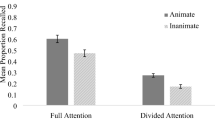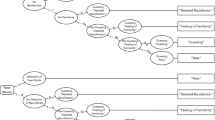Abstract
Piaget suggests that animistic thinking is a pervasive feature of children's cognition. To test this notion, 4- to 8-year-old children were shown several inanimate objects and asked to pick those which perform activities characteristic of living organisms. These activities were typified by six verbs: “eat,” “sleep,” “breathe,” “grow,” “die,”, and “be alive.” Fifty percent of the younger children responded animistically, by misattributing life processes to inanimate objects, but only 18% of their total responses were animistic. Twenty percent of the older children responded animistically, but only 20% of their responses were animistic. In Experiment II, children were shown drawings singly and asked if the object could perform activities named by one of the six verbs. Results were similar to those of Experiment I but with somewhat less animism. Experiment III required children to spontaneously name things that are alive. There were no animistic responses. It was concluded that animistic thinking is not a genuine phenomenon but linguistic confusion elicited by novel objects and unfamiliar words.
Similar content being viewed by others
References
Anglin, J. (1970).The Growth of Word Meaning, MIT Press, Cambridge, Mass.
Bruner, J. S., Goodnow, J., and Austin, G. A. (1956).A Study of Thinking, Wiley, New York.
Chomsky, N. (1965).Aspects of the Theory of Syntax, MIT Press, Cambridge, Mass.
Donaldson, M., and Wales, R. (1970). On the acquisition of some relational terms. In Hayes, J. R. (ed.).Cognition and the Development of Language, Wiley, New York.
Havighurst, R. J., and Neugarten, B. L. (1955). Belief in immanent justice and animism. In Havighurst, R. J. (ed.),American Indian and White Children: A Sociopsychological Investigation, University of Chicago Press, Chicago.
Howes, D. (1966). A word count of spoken English.J. Verb. Learn. Verb. Behav. 5:572–606.
Huang, I., and Lee, W. H. (1945). Experimental analysis of child animism.J. Genet. Psychol. 66:69–74.
Jahoda, G. (1958). Child animism. II. A study in West Africa.J. Soc. Psychol. 47:213–222.
Johnson, E. C., and Josey, C. C. (1931/1932). A note on the development forms of children as described by Piaget.J. Abnorm. Soc. Psychol. 26:338–339.
Katz, J. J., and Fodor, J. A. (1963). The structure of a semantic theory.Language 39:170–210.
Kuchera, H., and Francis, W. N. (1967).Computational Analysis of Present-Day American English, Brown University Press, Providence, R.I.
Laurendeau, M., and Pinard, A. (1962).Casual Thinking in the Child, International Universities Press, New York.
Looft, W., and Bartz, W. (1968). Animism revived.Psychol. Bull. 70:1–19.
Miller, G. A. (1969). A psychological method to investigate verbal concepts.J. Math. Psychol. 6:169–191.
Oakes, M. E. (1947). Children's explanations of natural phenomena.Teacher's College Contrib. Educ. No. 926.
Piaget, J. (1929).The Child's Conceptions of the World, Harcourt Brace Jovanovich, New York.
Rohrman, N. L. (1970). More on the Recall of Nominalizations.J. Verb. Learn. Verb. Behav. 9:534–536.
Russell, R. W. (1940a). Studies in animism. II. The development of animism.J. Genet. Psychol. 56:353–366.
Russell, R. W. (1940b). IV. An investigation of concepts allied to animism.J. Genet. Psychol. 57:83–91.
Russell, R. W., and Dennis, W. (1939). Studies in animism. I. A standardized procedure for the investigation of animism.J. Genet. Psychol. 55:389–400.
Russell, R. W., Dennis, W., and Ash, F. E. (1942). Studies in animism. V. Animism in older children.J. Genet. Psychol. 60:329–335.
Thorndike, E. L., and Lorge, I. (1944).The Teacher's Word Book of 30,000 Words, Teacher's College Press, New York.
Author information
Authors and Affiliations
Additional information
This work was supported by NSF Grant GB 23083.
A portion of the data of Experiment I constituted a Bachelor Honors Thesis conducted by the first author under the direction of the second and submitted to Florida State University. These data were presented at the meeting of the Southeastern Psychological Association, New Orleans, April 1973.
Rights and permissions
About this article
Cite this article
Holland, V.M., Rohrman, N.L. Distribution of the feature [+animate] in the lexicon of the child. J Psycholinguist Res 8, 367–378 (1979). https://doi.org/10.1007/BF01067140
Received:
Issue Date:
DOI: https://doi.org/10.1007/BF01067140




